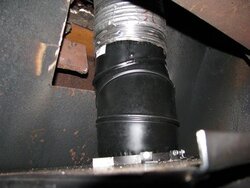I just had a company come out to install a fireplace insert. Overall, they were not being very careful when they were working and, as a result, scratched up the insert and insert cover so bad that I had to call the salesman while they were here to complain. They are coming this week to replace the whole insert unit except for the chimney liner. After they left I started looking at the chimney liner installation and noticed several potential issues:
1. There is no appliance connector between the flexible stainless steel liner and the fp insert. The forced the liner over top of a piece of stove pipe screwed into the fp insert. I've attached a picture. They also left a length of duck tape on it as seen in the picture. Not sure if it was to cover a hole or if it was already on the liner and they just didn't remove it. Is this going to really last? Is this something that would not pass inspection?
2. They didn't wrap the liner with insulation. I've made some calls. Some local installation companies say that it is not necessary and some say it is mandatory. I understand that it helps with draft and creosote buildup, but is it really necessary enough to really warrant the extra cost? I also read that it may help with making sure that the house doesn't catch fire from an overheated liner, but isn't that what the actual chimney is for?
Thanks for any help!
Eric
1. There is no appliance connector between the flexible stainless steel liner and the fp insert. The forced the liner over top of a piece of stove pipe screwed into the fp insert. I've attached a picture. They also left a length of duck tape on it as seen in the picture. Not sure if it was to cover a hole or if it was already on the liner and they just didn't remove it. Is this going to really last? Is this something that would not pass inspection?
2. They didn't wrap the liner with insulation. I've made some calls. Some local installation companies say that it is not necessary and some say it is mandatory. I understand that it helps with draft and creosote buildup, but is it really necessary enough to really warrant the extra cost? I also read that it may help with making sure that the house doesn't catch fire from an overheated liner, but isn't that what the actual chimney is for?
Thanks for any help!
Eric


